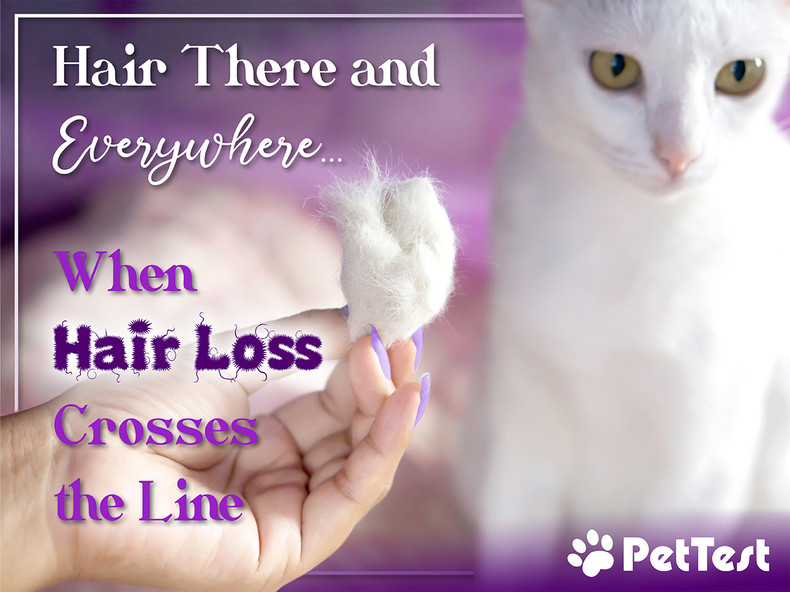Hair There and Everywhere - When Hair Loss Crosses the Line
Spring is coming… even if it doesn’t seem that way in some places. I know some areas are getting a nice day or even a few before plunging back into winter weather – Mother Nature can be such a tease! With warmer weather comes more shedding. Some cats shed year round, and cleaning out the kitty grooming brush seems like there is enough there for a whole other cat! As most kitty parents know, this is pretty normal. Your favorite sweater or blanket is never going to be a hair-free domain. With dogs AND cats, I practically have to dress at the door in order to go out with friends with pet allergies. We humans shed too. It is normal to get some hair in your hair brush or a strand or two on your pillow, for instance. When it changes from the normal we know into larger amounts of hair loss, it is time to investigate the problem.
Alopecia is an abnormal form of hair loss. First clues can include larger amounts of fur where kitty sleeps, clumps of fur around the house, or dullness to kitty’s coat. Alopecia is considered as bald areas or areas of very thin hair. This can be caused by a multitude of factors in kitty including stress, illness – yes, including our extra sweet diabetic kitties, medication side effects, and/or allergic reactions/irritations. Stressed cats can do some weird stuff which usually means hiding somewhere and absolutely refusing to acknowledge your calls without serious bribery with treats or catnip. However, serious forms of hair loss can be caused by lack of grooming – not necessarily caregiver neglect. An ill cat, like an ill human just is not going to have the energy to groom. (Anyone who has ever had the flu knows this feeling.) Over time, kitty’s fur can get tangled and matted up which can cause pulling of their delicate skin, irritation, and eventually a bald spot. Medications can cause hair loss as well including some anti-seizure medications, anti-inflammatory medications for pain, chemotherapy, and even some anti-anxiety medications. Generally speaking, with medication side effects, the shedding is heavier, and can eventually cause thinning of the coat or bald spots. If you think kitty is losing hair due to medication, you should talk to you veterinarian. Do not stop the medication. The hair loss may be a problem but that may be the trade-off for treating a major issue such as seizures. Switching medications may be an option, but not always. If a more serious condition is being treated and is well controlled on a certain medication, it may be worth the side effect.
Allergic reactions can cause all kinds of coat problems. If kitty develops hives, they may start pulling out their fur. I have had hives and wanted to crawl out of my own skin, so this I understand. If kitty is pulling out their fur, it is time to call the vet. This is a major stress reaction and indicates a problem. Aside from yanking on their own fur, which is disturbing enough, kitty can cause further skin injuries and infections. (Remember when mom said not to scratch at mosquito bites or chicken pox? You see where I am going.) If the source is not an allergic reaction, kitty could have a skin infection of some sort from decreased immunity due to illness or medication, being outside and exposed to something harmful or just bad luck.
Regardless of the cause, bald spots will make kitty’s skin more vulnerable to irritation and infection. Fur regulates body temperature and provides a protective shield to the skin from scratching and other normal everyday activities and hazards. Ask anyone with a hairless kitty – there is a lot of extra skin care required! You can read about it here if you don’t know anyone with a hairless cat. If kitty is losing a large amount of fur, your vet may recommend some of the care measures required for a hairless cat such as weekly bathing, special skin lotions or shampoo, and/or topical medication (with or without the cone of shame).
Alopecia is usually a symptom of something else. To be clear, I have had long-haired cats get a tangle and eventually have it fall out leaving an area of thinned hair or even a small bald spot for a short period of time. This is still hair loss within the range of normal and probably nothing to worry about. Thinning fur or multiple areas of balding with worsening over time or with signs of skin irritation is not within the normal range and should be addressed quickly. If kitty seems to be actively pulling on their fur excessively, regardless of other visible symptoms, it is time to call your vet to prevent self-injury.
As always, you can find specifics and a lot of help on the Feline Diabetic Support Group on FB.

